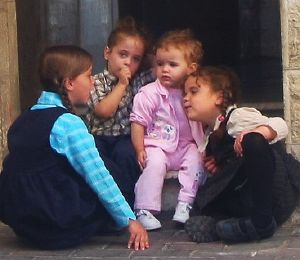Difference between revisions of "Childhood" - New World Encyclopedia
| Line 17: | Line 17: | ||
==History== | ==History== | ||
| + | [[Image:Su Han Ch'en 001.jpg|thumb|right|200px|''Playing Children'', by [[Song Dynasty]] Chinese artist Su Hanchen.]] | ||
[[Philippe Ariès]], an important French [[medievalist]] and [[historian]], published a study in 1961 of paintings, gravestones, furniture, and school records. He found that before the seventeenth century, children were represented as mini-[[adults]]. Since then historians have increasingly begun to research childhood in past times. | [[Philippe Ariès]], an important French [[medievalist]] and [[historian]], published a study in 1961 of paintings, gravestones, furniture, and school records. He found that before the seventeenth century, children were represented as mini-[[adults]]. Since then historians have increasingly begun to research childhood in past times. | ||
| Line 23: | Line 24: | ||
Several historical events and period are discussed as relevant to the history of childhood in the West. One such event is the life of [[Jesus Christ]]<ref name=Wilde>Wilde, Oscar. ''De profundis''. Dover Publications New York, 1996.</ref> Christ taught that children were to be loved and revered, a departure from the ancients' attitude to children which was to be propagated in the [[Roman Empire]] during the next 400 years with the introduction of Christianity.{{Fact|date=February 2007}} | Several historical events and period are discussed as relevant to the history of childhood in the West. One such event is the life of [[Jesus Christ]]<ref name=Wilde>Wilde, Oscar. ''De profundis''. Dover Publications New York, 1996.</ref> Christ taught that children were to be loved and revered, a departure from the ancients' attitude to children which was to be propagated in the [[Roman Empire]] during the next 400 years with the introduction of Christianity.{{Fact|date=February 2007}} | ||
| − | During the [[Renaissance]], artistic depictions of children increased dramatically in Europe. This did not impact the social attitude to children much, | + | During the [[Renaissance]], artistic depictions of children increased dramatically in Europe. This did not impact the social attitude to children much, however—see the article on [[child labour]]. |
The [[Victorian Era]] has been described as a source of the modern institution of childhood. Ironically, the [[Industrial Revolution]] during this era led to an increase in child labour, but due to the campaigning of the [[Evangelicals]], and efforts of author [[Charles Dickens]] and others, child labour was gradually reduced and halted in England via the [[Factory Acts]] of 1802-1878. The Victorians concomitantly emphasized the role of the family and the sanctity of the child, and broadly speaking, this attitude has remained dominant in [[Western world|Western]] societies since then. | The [[Victorian Era]] has been described as a source of the modern institution of childhood. Ironically, the [[Industrial Revolution]] during this era led to an increase in child labour, but due to the campaigning of the [[Evangelicals]], and efforts of author [[Charles Dickens]] and others, child labour was gradually reduced and halted in England via the [[Factory Acts]] of 1802-1878. The Victorians concomitantly emphasized the role of the family and the sanctity of the child, and broadly speaking, this attitude has remained dominant in [[Western world|Western]] societies since then. | ||
| − | |||
| − | |||
| − | |||
| − | |||
| − | |||
==Legal definition of child== | ==Legal definition of child== | ||
| Line 39: | Line 35: | ||
In a New York court ruling in 2006 on the eviction of a pregnant woman, the court declared that her child was equally protected under the law although the eviction notice was served before the child was born.<ref>{{cite web|title=Tens of thousands of children evicted without a warrant.|url=http://www.pr-inside.com/tens-of-thousands-of-children-evicted-r27047.htm |publisher=EMAILWIRE.COM,|date=[[2006-11-24 ]]}}</ref> | In a New York court ruling in 2006 on the eviction of a pregnant woman, the court declared that her child was equally protected under the law although the eviction notice was served before the child was born.<ref>{{cite web|title=Tens of thousands of children evicted without a warrant.|url=http://www.pr-inside.com/tens-of-thousands-of-children-evicted-r27047.htm |publisher=EMAILWIRE.COM,|date=[[2006-11-24 ]]}}</ref> | ||
| + | |||
| + | |||
| + | ===Unaccompanied minor=== | ||
| + | Some airlines provide special services to a passenger who is an '''Unaccompanied Minor (UM)'''. These may be compulsory paid services. | ||
| + | |||
| + | There may be special rules for [[Right of asylum|asylum]]-seeking unaccompanied minors. | ||
== Child development == | == Child development == | ||
| Line 44: | Line 46: | ||
''[[Child development]]'' is the study of the processes and mechanisms that accompany the physical and mental development of an infant as it matures. | ''[[Child development]]'' is the study of the processes and mechanisms that accompany the physical and mental development of an infant as it matures. | ||
| − | + | [[Pediatrics]] is the branch of [[medicine]] relating to the care of children from infancy through adolescence, and sometimes even young adults (ages 0–21 years). | |
These age ranges are approximate, and may differ from culture to culture. The following list reflects the concept of child development in the 21st century. | These age ranges are approximate, and may differ from culture to culture. The following list reflects the concept of child development in the 21st century. | ||
| Line 58: | Line 60: | ||
* [[Adolescence|Adolescence and puberty]] (teenager) (13–19). | * [[Adolescence|Adolescence and puberty]] (teenager) (13–19). | ||
| − | + | '''List of child related articles''' | |
| − | |||
| − | |||
| − | |||
| − | |||
| − | |||
| − | |||
| − | |||
| − | |||
| − | |||
| − | |||
| − | |||
| − | |||
| − | |||
| − | |||
| − | |||
| − | |||
| − | |||
* [[Child abuse]] | * [[Child abuse]] | ||
| − | |||
* [[Child custody]] | * [[Child custody]] | ||
* [[Child development]] | * [[Child development]] | ||
| − | |||
* [[Child labor]] | * [[Child labor]] | ||
* [[Child prodigy]] | * [[Child prodigy]] | ||
* [[Child sexual abuse]] | * [[Child sexual abuse]] | ||
| − | |||
| − | |||
* [[Child support]] | * [[Child support]] | ||
* [[Childcare]] | * [[Childcare]] | ||
| − | |||
| − | |||
| − | |||
| − | |||
| − | |||
* [[Education]], [[School]] | * [[Education]], [[School]] | ||
* [[Educational psychology]] | * [[Educational psychology]] | ||
| − | |||
| − | |||
| − | |||
| − | |||
| − | |||
* [[Parenting]] | * [[Parenting]] | ||
| − | |||
| − | |||
* [[Pedophilia]] | * [[Pedophilia]] | ||
* [[Pedagogy]] | * [[Pedagogy]] | ||
| − | * [[Play (activity)| | + | * [[Play (activity)|Play]] |
| − | |||
| − | |||
| − | |||
| − | |||
| − | |||
| − | |||
| − | |||
==Notes== | ==Notes== | ||
| Line 149: | Line 111: | ||
*[http://www.yesterdays.sk/kategorie.php?id=29 Historical children photos] | *[http://www.yesterdays.sk/kategorie.php?id=29 Historical children photos] | ||
*[http://www.childhood.org/frame.aspx?lang=en World Childhood Foundation] | *[http://www.childhood.org/frame.aspx?lang=en World Childhood Foundation] | ||
| − | |||
| − | |||
| − | |||
| − | |||
| − | |||
| − | |||
{{credits|Childhood|145531859|Child|149284136}} | {{credits|Childhood|145531859|Child|149284136}} | ||
Revision as of 22:17, 28 November 2007
Childhood (being a child) is a broad term usually applied to the phase of development in humans between infancy and adulthood.



A child (plural: children) is a boy or girl who has not reached puberty, but also refers to offspring of any age. Adults remain the children of their parents, no matter what their age. It can be applied to non-human offspring, as in the child node of a tree.
Definition
In recent years there has been a rapid growth of interest in the sociological study of childhood. Reaching on a large body of contemporary sociological and anthropological research, people have developed key links between the study of childhood and social theory, exploring its historical, political, and cultural dimensions.
History

Philippe Ariès, an important French medievalist and historian, published a study in 1961 of paintings, gravestones, furniture, and school records. He found that before the seventeenth century, children were represented as mini-adults. Since then historians have increasingly begun to research childhood in past times.
Before Ariès, George Boas had published The Cult of Childhood.
Several historical events and period are discussed as relevant to the history of childhood in the West. One such event is the life of Jesus Christ[1] Christ taught that children were to be loved and revered, a departure from the ancients' attitude to children which was to be propagated in the Roman Empire during the next 400 years with the introduction of Christianity.[citation needed]
During the Renaissance, artistic depictions of children increased dramatically in Europe. This did not impact the social attitude to children much, however—see the article on child labour.
The Victorian Era has been described as a source of the modern institution of childhood. Ironically, the Industrial Revolution during this era led to an increase in child labour, but due to the campaigning of the Evangelicals, and efforts of author Charles Dickens and others, child labour was gradually reduced and halted in England via the Factory Acts of 1802-1878. The Victorians concomitantly emphasized the role of the family and the sanctity of the child, and broadly speaking, this attitude has remained dominant in Western societies since then.
Legal definition of child
The legal definition of "child" is interchangeable with minor and may vary by country, in keeping with cultural conceptions.
The United Nations Convention on the Rights of the Child, often referred to as CRC or UNCRC, an international convention setting out the civil, political, economic, social, and cultural rights of children, defines a child as "every human being below the age of 18 years unless under the law applicable to the child, majority is attained earlier." [2]
In a New York court ruling in 2006 on the eviction of a pregnant woman, the court declared that her child was equally protected under the law although the eviction notice was served before the child was born.[3]
Unaccompanied minor
Some airlines provide special services to a passenger who is an Unaccompanied Minor (UM). These may be compulsory paid services.
There may be special rules for asylum-seeking unaccompanied minors.
Child development
Child development is the study of the processes and mechanisms that accompany the physical and mental development of an infant as it matures.
Pediatrics is the branch of medicine relating to the care of children from infancy through adolescence, and sometimes even young adults (ages 0–21 years).
These age ranges are approximate, and may differ from culture to culture. The following list reflects the concept of child development in the 21st century.
- Zygote, the point of Conception, fertilization.
- Embryo; in the later stages also called fetus.
- Neonate (newborn) in the first month outside of the womb.
- Infant (baby) (ages 0–1.5).
- Toddler (ages 1.5–4).
- Middle childhood - Primary school/Elementary school age (ages 5–10).
- Prepubescence, a subset of the above (ages 10–11, approximately).
- Preadolescence (preteen, or middle school age) (ages 11–13, approximately). Note overlap with prepubesent stage of middle childhood.
- Adolescence and puberty (teenager) (13–19).
List of child related articles
- Child abuse
- Child custody
- Child development
- Child labor
- Child prodigy
- Child sexual abuse
- Child support
- Childcare
- Education, School
- Educational psychology
- Parenting
- Pedophilia
- Pedagogy
- Play
Notes
- ↑ Wilde, Oscar. De profundis. Dover Publications New York, 1996.
- ↑ Convention on the Rights of the Child. Office of the United Nations High Commissioner for Human Rights (1989-11-20). Ratified by 192 of 194 member countries.
- ↑ Tens of thousands of children evicted without a warrant.. EMAILWIRE.COM, (2006-11-24 ).
ReferencesISBN links support NWE through referral fees
- Ariès, Philippe. Centuries of Childhood: A Social History of Family Life. New York: Alfred A. Knopf, 1962.
- Boas, George. The Cult of Childhood. London: Warburg, 1966.
- Brown, Marilyn R., ed. Picturing Children: Constructions of Childhood between Rousseau and Freud. Aldershot: Ashgate, 2002.
- Buckingham, David. After the Death of Childhood: Growing Up in the Age of Electronic Media. Blackwell Publishers, 2000. ISBN 0745619339.
- Bunge, Marcia J., ed. The Child in Christian Thought. Grand Rapids, MI: William B. Eerdmans Publishing Co., 2001.
- Calvert, Karin. Children in the House: The Material Culture of Early Childhood, 1600-1900. Boston: Northeastern University Press, 1992.
- Cleverley, John and D.C. Phillips. Visions of Childhood: Influential Models from Locke to Spock. New York: Teachers College, 1986.
- Cunningham, Hugh. Children and Childhood in Western Society since 1500. London: Longman, 1995.
- Cunnington, Phillis and Anne Buck. Children’s Costume in England: 1300 to 1900. New York: Barnes & Noble, 1965.
- deMause, Lloyde, ed. The History of Childhood. London: Souvenir Press, 1976.
- Higonnet, Anne. Pictures of Innocence: The History and Crisis of Ideal Childhood. London: Thomas and Hudson Ltd., 1998.
- Immel, Andrea and Michael Witmore, eds. Childhood and Children’s Books in Early Modern Europe, 1550-1800. New York: Routledge, 2006.
- Kincaid, James R. Child-Loving: The Erotic Child and Victorian Culture. New York: Routledge, 1992.
- Müller, Anja, ed. Fashioning Childhood in the Eighteenth Century: Age and Identity. Burlington, VT: Ashgate, 2006.
- O’Malley, Andrew. The Making of the Modern Child: Children’s Literature and Childhood in the Late Eighteenth Century. London: Routledge, 2003.
- Pinchbeck, Ivy and Margaret Hewitt. Children in English Society. 2 vols. London: Routledge, 1969.
- Pollock, Linda A. Forgotten Children: Parent-child relations from 1500 to 1900. Cambridge: Cambridge University Press, 1983.
- Postman, Neil. The Disappearance of Childhood. New York: Vintage, 1994.
- Shorter, Edward. The Making of the Modern Family.
- Sommerville, C. John. The Discovery of Childhood in Puritan England. Athens: University of Georgia Press, 1992.
- Steinberg, Shirley R. and Joe L. Kincheloe. Kinderculture: The Corporate Construction of Childhood. Westview Press Inc., 2004. ISBN 081339157.
- Stone, Lawrence. The Family, Sex and Marriage in England 1500-1800. New York: Harper and Row, 1979.
- Zornado, Joseph L. Inventing the Child: Culture, Ideology, and the Story of Childhood. New York: Garland, 2001.
External links
- CDC's "Learn the Signs. Act Early.” campaign - Information for parents on early childhood development and developmental disabilities
- Historical children photos
- World Childhood Foundation
Credits
New World Encyclopedia writers and editors rewrote and completed the Wikipedia article in accordance with New World Encyclopedia standards. This article abides by terms of the Creative Commons CC-by-sa 3.0 License (CC-by-sa), which may be used and disseminated with proper attribution. Credit is due under the terms of this license that can reference both the New World Encyclopedia contributors and the selfless volunteer contributors of the Wikimedia Foundation. To cite this article click here for a list of acceptable citing formats.The history of earlier contributions by wikipedians is accessible to researchers here:
The history of this article since it was imported to New World Encyclopedia:
Note: Some restrictions may apply to use of individual images which are separately licensed.